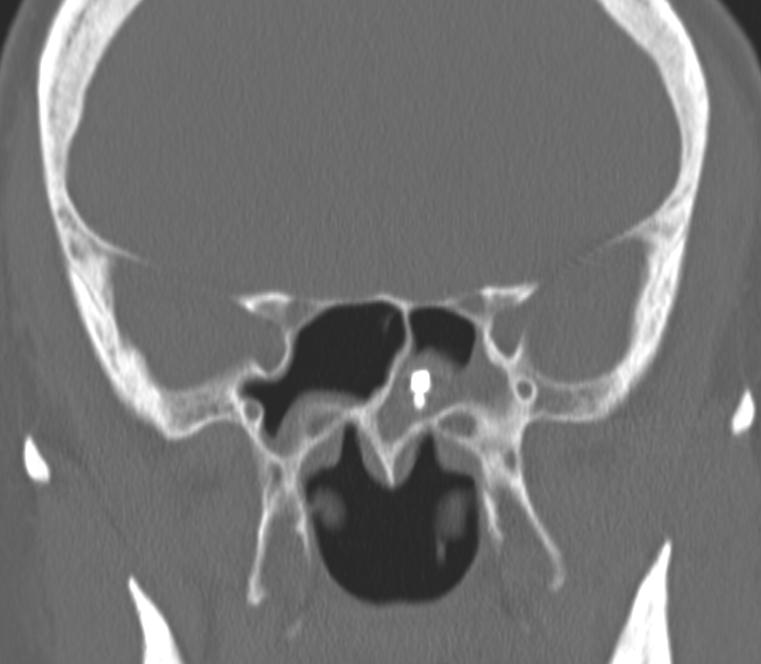Foreign body, Sphenoid sinus, Silver nitrate, Sinusitis, Computed tomography
This case describes the incidental finding of a metallic foreign body in a patient presenting with recurrent chronic rhinosinusitis.
A 68-year-old female who underwent bilateral Functional Endoscopic Sinus Surgery (FESS) in 2000 for chronic rhinosinusitis, presented with a one year history of recurrent headaches. The headaches were located particularly around the eyes, occurred weekly and improved with paracetamol. She also complained of anosmia and purulent rhinorrhea bilaterally. Her nasal airway was subjectively patent. She commented that on multiple occasions over the past decade she had been seen in the Emergency Department with epistaxis and treated with silver nitrate. She was on warfarin for a mitral valve replacement secondary to rheumatic heart disease.
On examination anterior rhinoscopy showed a central septum and unremarkable inferior turbinates. Rigid nasendoscopy revealed mucopurulent material flowing from the left sphenoethmoidal recess. Non-contrast CT of the sinuses showed mucosal thickening throughout all of the paranasal sinuses with incomplete opacification of the ethmoid air cells. A 6 mm × 3 mm density suggestive of a metallic foreign body was noted within the left sphenoid sinus with surrounding bony sclerosis. Metallic material was also noted within the left parapharyngeal fat medial to the left mandibular neck. The patient herself denied any knowledge of this foreign body or past traumatic events. Given her recurrent extensive sinus disease and presence of unknown metallic foreign body she underwent revision bilateral FESS with removal of foreign body (Figure 1, Figure 2 and Figure 3).
 Figure 1: Non-contrast Computed Tomography (CT) of the sinuses in axial plane with evidence of a metallic foreign body in the left sphenoid sinus.
View Figure 1
Figure 1: Non-contrast Computed Tomography (CT) of the sinuses in axial plane with evidence of a metallic foreign body in the left sphenoid sinus.
View Figure 1
 Figure 2: Non-contrast Computed Tomography (CT) of the sinuses in coronal plane with evidence of a metallic foreign body in the left sphenoid sinus.
View Figure 2
Figure 2: Non-contrast Computed Tomography (CT) of the sinuses in coronal plane with evidence of a metallic foreign body in the left sphenoid sinus.
View Figure 2
 Figure 3: Non-contrast Computed Tomography (CT) of the sinuses in sagittal plane with evidence of a metallic foreign body in the left sphenoid sinus.
View Figure 3
Figure 3: Non-contrast Computed Tomography (CT) of the sinuses in sagittal plane with evidence of a metallic foreign body in the left sphenoid sinus.
View Figure 3
In the operating room the foreign body was identified in the inferior part of the sphenoid sinus and was removed with suction. The foreign body was then examined and found to be a 5 mm piece of what appeared to be silver nitrate encased in a granulomatous material. Post-operative day five the patient had significant epistaxis and underwent bilateral sphenopalatine artery ligation.
Silver nitrate is a commonly used form of chemical cautery in patients who present with epistaxis. It is an inorganic oxidizing agent that produces free radicals and heat in an aqueous solution. This causes a necrotic cellular reaction that promotes haemostasis by coagulation [1]. There are only a few case reports that describe silver nitrate as a foreign body identified by radiological investigation in the body [2]. Following literature review this appears to be only the second case report describing the appearance of silver nitrate on a CT scan in the head and neck region of the body [3]. In our case the silver nitrate appeared to be causing the disease process. This was evident by the surrounding granulomatous change, mucosal thickening, and sclerotic bone noted at the time of imaging and at operation. It is assumed that this silver nitrate tip migrated to the sphenoid sinus following cauterisation on one of the many visits to the Emergency Department.
There are several learning points in this case. Firstly, care must be taken when using silver nitrate in the nasal cavity secondary to the risk of tip dislodgement and subsequent migration into the paranasal sinuses. Use of silver nitrate must be documented in the clinical notes, particularly if it is noted that the tip is no longer present following cauterisation. Our patient is now well and reports no ongoing sinus or nasal symptoms.